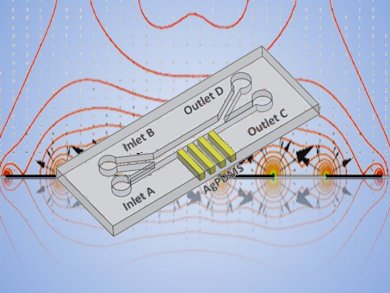“Dielectrophoresis is the movement of particles in a non-uniform electric field due to the interaction of the particle’s dipole and spatial gradient of the electric field. Among other methods, dielectrophoresis is one of the most popular methods for particle manipulation in microsystems due to (i) its label-free nature, (ii) its favorable scaling effects, (iii) the simplicity of the instrumentation and (iv) its ability to induce both negative and positive forces.
Dielectrophoresis force depends on the size and the electrical properties of the particles and the suspending medium. Dielectrophoresis is applicable even for non-conducting particles and can be generated either by using direct current (DC) or alternating current (AC) field. DC-DEP, AC-DEP and DC-biased AC-DEP have been successfully implemented for the manipulation of micro/nanoparticles” [1].
“Fifty-five years after the first work by Pohl and Hawk [2], dielectrophoresis is becoming an important scientific direction with exponential growth. With over 300 papers published yearly in the past three years, it is becoming one of the main pillars of the field of microfluidics. New and effective dielectrophoretic modes and techniques are being constantly developed and reported in the literature. The great flexibility and potential that dielectrophoresis has to offer make it suitable for applications in a wide variety of fields, with important and attractive advantages over traditional bench-scale systems” [3]. These include:
- the manipulation of a wide range of nanosized particles, from semiconducting particles, to DNA, nanowires and graphene;
- monitoring of microorganisms, from viruses to protozoa, in environmental applications;
- cell characterization, manipulation, separation and patterning; as well as
- use in biomedical and clinical applications, e.g. the exploration and manipulation of red blood cells and cancer cells.
Electrophoresis presents a virtual issue on dielectrophoresis comprising the 25 most-downloaded articles in the field published over the last two years.
- Dielectrophoresis, Virtual Issue of Electrophoresis
Compiled of the 25 most-downloaded articles in the field published over the last two years
- Special Issue on Dielectrophoresis; Part 1,
Electrophoresis 2011, 32 (17), 2231–2399. - Special Issue on Dielectrophoresis; Part 2,
Electrophoresis 2011, 32 (18), 2231–2578.[1] B. Çetin, D. Li, Electrophoresis 2011, 32, 2410–2427. DOI: 10.1002/elps.201100167
[2] H. A. Pohl, I. Hawk, Science 1966, 152, 647–649. DOI: 10.1126/science.152.3722.647-a
[3] B. H. Lapizco-Encinas, F. Foret, Electrophoresis 2011, 32, 2231. DOI: DOI: 10.1002/elps.201190074



